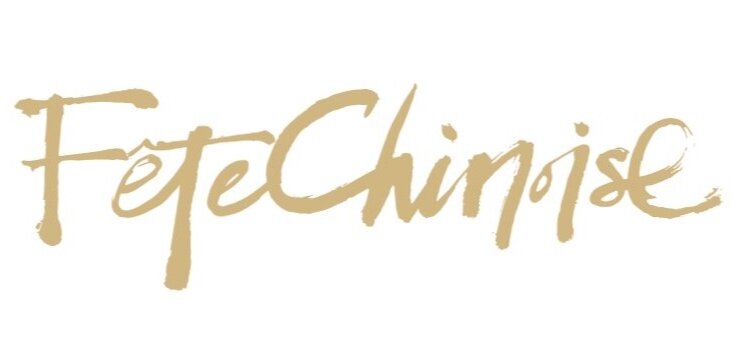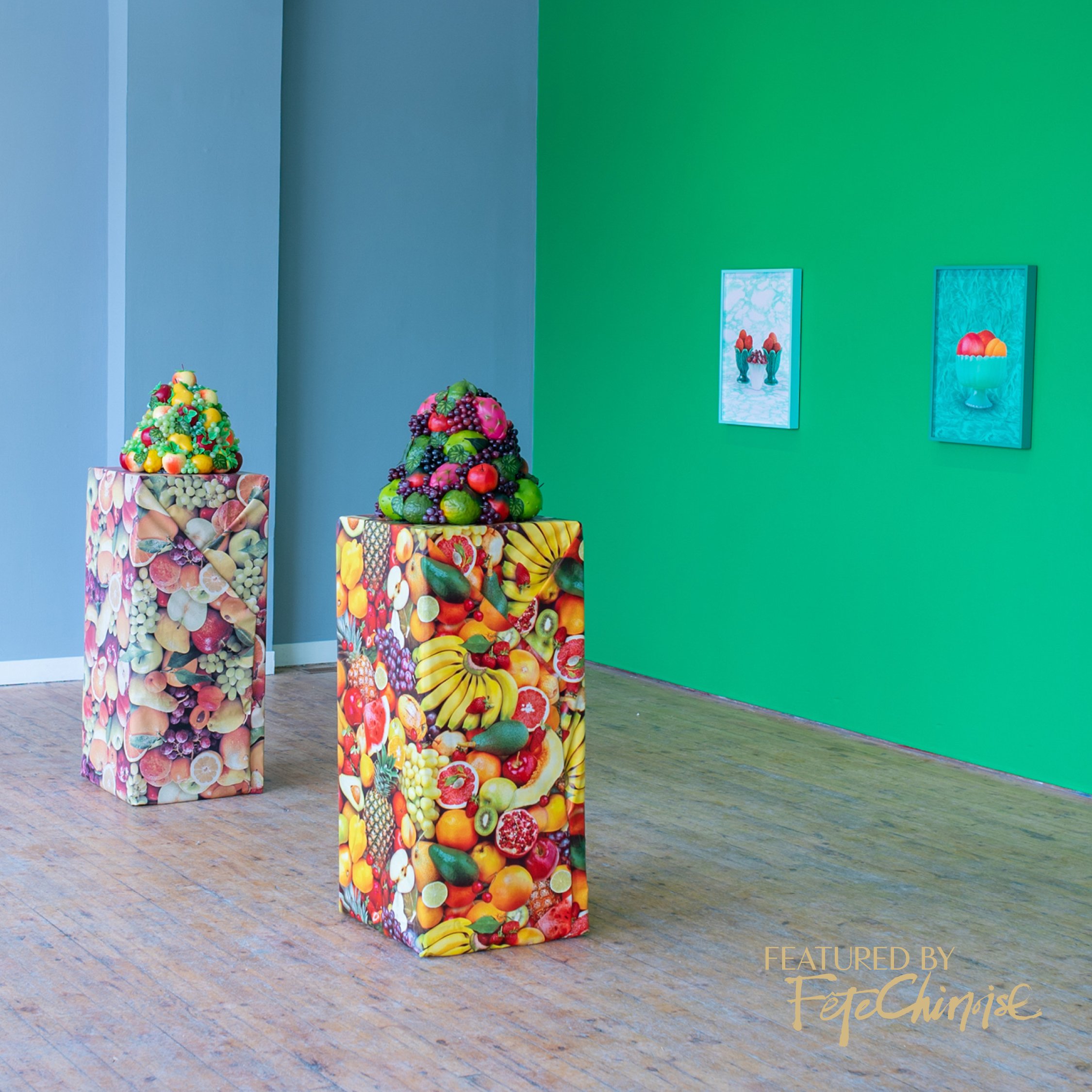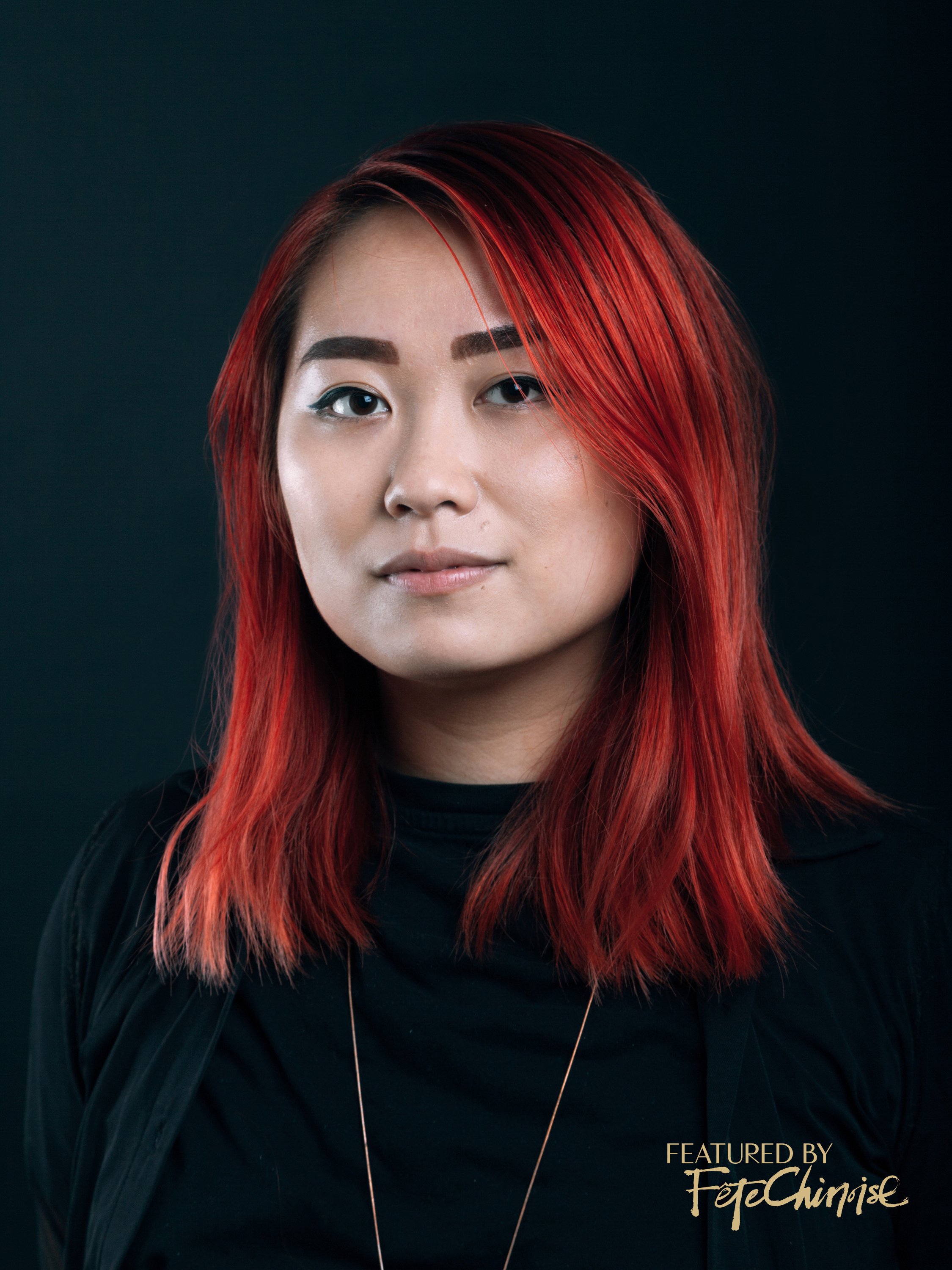Abundance: Across Oceans and Generations by Toronto artist Shellie Zhang 張雪萊
Interviewed by Fete Chinoise Team
Photography: Courtesy of shellie zhang
As featured in Edition No. 6 of Fete Chinoise Magazine: Time + Tempo
The project features different arrangements of both fake and real fruits and vegetables in bowls taken from my home and collection of family heirlooms. In this series, I provide a visual for the dreams and labour that extends across oceans and generations. Most of the produce featured cannot be grown in Canada, signifying a longing for flavours grown in homelands and the strenuous process of bringing them here. Presented alongside domestic wares such as tablecloths or bowls, each work conjures the loaded familial act of fruit being served, gifted or received. Combining visual cues from imagery of plentiful fruit in produce advertisements, still life paintings, bowls of decorative produce displayed in restaurants, offerings at shrines/temples and the tradition of gifting fruit, Abundance looks at how we connect to the spiritual and natural world through the things that we imbue with meaning.
我的最新項目“Abundance”是一組以雕塑、攝影和裝置為基礎的新作品,反映了“Abundance”對我的兩種意義—第一,我的親戚在年輕時帶著切好的水果;第二,在墳墓旁留下了水果。該項目用碗盛放了真假兩種水果,擺放在在藝術家家中,就此拍攝一系列的照片。在本系列中,我塑造了具有跨越海洋和跨越時空的夢想般的視覺效果。大部分呈現的特色產品無法在加拿大種植,這表明人們對家鄉風味的渴望,以及將其帶到海外的艱苦過程。與諸如桌布或碗之類的家庭用品一起展示時,每件作品都讓人聯想到一些與水果有關的禮儀與習慣。結合了豐富水果圖像的視覺提示、靜物畫、餐廳中陳列的裝飾品、廟宇的供品,以及送水果的傳統,“Abundance”系列讓我們更瞭解我們賦予不同物品的意義所在。
The project is comprised of two bodies of work. Offerings to Both Past and Future is a series of photographs in which fruits and vegetables are presented as tender jewels on delicate pedestals to chronicle sacrifice, care, affection and labour. Created as tributes, Offerings to Both Past and Future aims to sustain the collective memory of those in the afterlife and those in the present. Situated within the everyday, these photographs serve as reminders of the past and wishes for the future. In Cornucopias, vibrant piles of fruit were created from plastic and rubber replicas purchased from kitchen supply stores and home décor shops. As many of the fruits displayed cannot be grown or cultivated here in Canada, Cornucopias examines how artificial substitutes are utilized as a stand-in for their organic counterparts.
該項目由兩個系列作品組成。“Offerings to Both Past and Future”(過去和未來的奉獻)是其中一個系列,其中水果和蔬菜被視為寶貴的珠寶呈現在精緻的基座上,以記述家人的犧牲,關懷,愛護和勞動,這組作品旨在維持對現時與來世的人們的集體記憶,這些日常生活照片可同時喚起過去和代表對未來的祝福;“Cornucopias”(聚寶盆)用從廚房用品店和家庭裝飾店購買的塑膠和橡膠製成的水果組成了充滿活力的水果堆,由於展示的許多無法在加拿大本地種植或種植的塑膠水果,“Cornucopias”進行了利用人工替代品來替代水果實物的探索。
The longstanding history that fruit and vegetables have played in Chinese visual culture, rituals and symbolism can seen through a contemporary lens in Abundance. In Chinese mythology, peaches of immortality are consumed by the immortals due to their mystic virtue of conferring longevity on all who eat them. Today, peaches make frequent appearances in both fruit and confectionery forms at birthdays. Peaches are also commonly seen to embody softness, suppleness, and femininity. Still Life with Peaches and Nectarines unites these varying symbolisms and combines them to form a testament to femme longevity and perseverance.
sponsored by piaget.
Still Life with Bitter Melon and Still Life with Bitter Melons features both white and green bitter melons from grocery markets and home gardens. Found in Caribbean, Southeast Asia and Chinese cuisine, bitter melons are touted for their medicinal properties.
I would see these growing on the front lawns of gardens in my old neighbourhood of Little Portugal. Despite it’s unfortunate name, here in Offerings to Both Past and Future, bitter melons are given its due respect for its healing capabilities, beautiful form and the work it took for them to grow in a pearlescent display against marble.
透過“Abundance”的現代視角,可以從水果和蔬菜構成的作品中體現中國視覺文化,進而呈現其中的禮節和悠久歷史。在中國神話中,不朽的桃子代表長壽。今天,桃子在過生日時仍然經常以水果本身或不同形式出現。桃子也會被視為柔軟和女性化的體現。“Still Life with Peaches and Nectarines”將這些不同的象徵結合在一起,展現了對女性長壽和毅力的表達。
The project was inspired by and came to fruition around the same time as the Qingming (清明) Festival, also known as Tomb-Sweeping Day or Ancestors’ Day. This ritual was an influential element in the development of Abundance. During Qingming, Chinese families visit the tombs of their ancestors to clean the gravesites, pray to their ancestors, and make ritual offerings. Offerings typically include burning incense sticks, joss paper (money for the dead), fruit, flowers, food and tea. This year, the festival occurred on April 4. However, due to the COVID-19 outbreak, authorities across Asia urged the public to stay away and to make “digital offerings” where they can perform tomb sweeping rituals online, or to pay a fee for ask the cemetery staff to conduct it on their behalf.
該項目的靈感來自清明節。清明期間,中國家庭會去其祖先的墳墓清理墓地,向祖先祈禱並祭祀。祭品通常包括燒香、香紙、水果、鮮花、食物和茶等。2020年的清明節是4月4日,但是由於新冠病毒爆發,亞洲各地敦促公眾遠離墓地,並提供“數位化祭掃”,人們可在網上進行掃墓儀式或要求墓地工作人員幫助他們完成祭掃。
張雪萊 shellie zhang
During a time where we desire community solidarity, family and friends in the midst of distance and isolation, how can we create rituals where we can pause, reflect and give thanks? Abundance asks audiences to contemplate on how they can incorporate acts of reverence, tribute and acknowledgement into their everyday practices and develop individual connections to heritage, tradition and spirituality.
在我們渴望社區團結,而家人和朋友都不能陪伴我們的時候,我們如何尋找一些讓我們停下來反思的日常習俗呢?“Abundance”希望觀眾會繼續思
考如何將一些習俗行為融入日常活動中,使個人更緊密地與傳統、文化傳承和宗教神靈進行聯繫。

















As the moon prepares to shine at its fullest during the Mid-Autumn Festival, TUDOR introduces a timely new addition to its collection: the 1926 Luna, the brand’s first watch featuring a moon phase complication. Designed in collaboration with TUDOR ambassador Jay Chou, the release draws inspiration from Eastern lunar traditions, offering a mechanical tribute to a cultural moment that celebrates family, unity, and reflection under the moonlight.